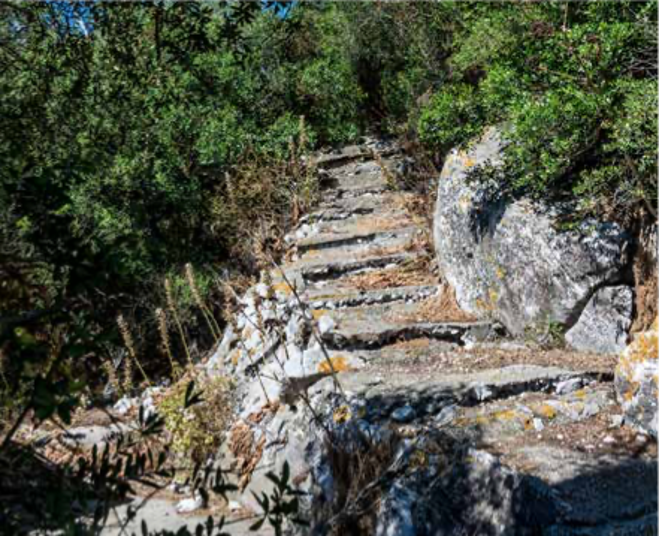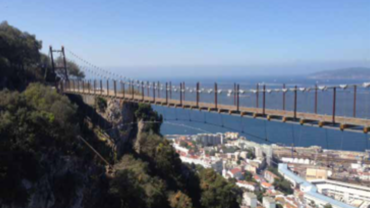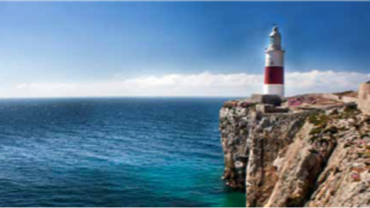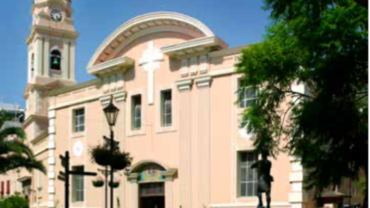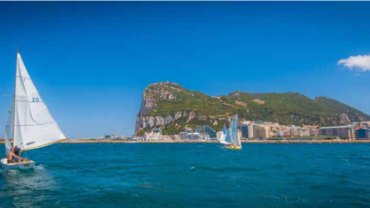The Nature Reserve Pass of Gibraltar
City Under Siege
Whilst it is true that during the early part of the British occupation of Gibraltar most of the population were members of the Armed Forces, and in particular the Army, the civilian population also contributed to the war effort and played an important role in the life of the Garrison. The buildings in which this exhibition is housed are probably amongst the first buildings ever constructed by the British in Gibraltar, thus dating back to the beginning of the 18th century. Originally it is thought that they were built as magazines to store ammunition and that the building in the courtyard, part of which can still be seen today, was used as a laboratory to prepare ammunition. The area is known as Willis’s Magazine although there is no record of who Willis was and why it was given that name.
Undoubtedly the most important aspect of the building is the graffiti that can be seen on the walls, the earliest of which dates back to 1726. It is thought that soldiers mounting guard in the area used to spend their time drawing graffiti so as not to fall asleep during the long hours of duty, an offence punishable by death in those days. There is much graffiti, all equally interesting, yet there are two outstanding ones featuring a drawing of a galleon together with a graffiti attributed to Sergeant Major Ince, the architect of the Great Siege Tunnels. In this area the visitor can also see the water cisterns used in those days together with the drainage system.
The various exhibits within this area of great historical value depict scenes of how the civilian population lived during those hard times and relate the quaint and often fascinating stories that have passed down to our days of how the first British settlers of Gibraltar had to cope with life.
LAW AND ORDER
Under siege conditions, the mixture of tension, boredom, anger and alcohol meant that discipline had to be strict if order was to be preserved. One of the most common forms of punishment was flogging with a nine tailed whip. A drummer in a regiment, which later became the Lancashire Fusiliers, achieved fame as the most flogged man in the British army. In his first 14 years here he received 30,000 lashes, of which 4,000 were administered in a single year.
FOOD
To preserve stocks of flour, General Eliott stopped his soldiers from powdering their hair and to set everyone a good example he even lived for a week on 4 ounces of rice a day. The high prices that could be charged for even small quantities of poor quality food tempted ships from North Africa to smuggle supplies past the enemy, but civilians often survived on little more than grass, seaweed and wild onions. During the Great Siege a cabbage cost the equivalent of two and a half days of a soldier’s pay while the head and feet of a sheep sold for more than three weeks wages!
EXODUS
To escape the bombardment people gradually abandoned their homes, until the whole population had settled south of the city in tents and ramshackle huts made from timber salvaged from their ruined houses.
This encampment between South Barracks and the Mount was at first called New Jerusalem but because of the dreadful conditions it quickly became known as “Black Town”. Even General Elliot moved his headquarters to a tent above the area known as “Red Sands”
DIG FOR VICTORY
The besieged population lacked fresh vegetables and citrus fruits, important sources of vitamin C. Vitamin C deficiency cause the flesh to blacken and can cripple and kill. To combat this deadly condition, which almost forced the city to surrender, soldiers and civilians were ordered to grow food wherever possible. General Elliot must have taken a very keen interest since he was, most unusually for this period, a strict vegetarian
DEATH AND DISEASE
During the siege, many people on a poor diet were closely confined for long periods in unsanitary conditions.
It is hardly surprising that smallpox, yellow fever, influenza, dysentery and scurvy thrived. By the end of the first year of the Great Siege, smallpox, alone had killed over 500, with the highest mortality rate amongst the children. Although the chart below contains details of the military losses, it quite clearly shows that diseases were much more dangerous than cannon balls.
Apes’ Den / Barbary Macaques
Perhaps Gibraltar’s most important tourist attraction, the Barbary Macaques are normally found in North Africa, but their presence in Gibraltar probably dates from the early days of the British garrison when it is presumed that they were imported, inevitably finding the rough limestone cliffs and scrub vegetation a congenial habitat. In fact, many legends have grown up around them. One is that they travelled from their native Morocco via a subterranean tunnel starting at St Michael’s Cave leading down underneath the Strait of Gibraltar.
Another legend claims that, should the macaques ever disappear, the British will leave Gibraltar. During the last war, natural causes had diminished the macaque numbers alarmingly. Fortunately, Sir Winston Churchill took a personal interest and additional animals were imported from Morocco. Today, in addition to the pack resident at Apes’ Den, there are other packs living wild on the steep slopes of the Rock. Gibraltar does not wish to lessen ‘the monkey experience’ but experts have warned that too much human interaction is harmful to these wild animals.
Primarily because we want them to remain living as they are, in a semi-wild state, we strongly advise you not to get too close, feed or touch them. Finally, because they are wild animals, they may react violently and have been known to attack and inflict serious bites. By all means take photographs but please allow the monkeys to live a natural, free life for their benefit and the enjoyment of all. Just keep a safe distance, do not shout or make sudden movements.
Explore the World War II Tunnels
With the entry of Italy into the War, and a powerful Germany dominating Europe, the strategic importance of Gibraltar grew. The problem of storage was urgent and vital; space became even more valuable; stores, food, and equipment had to be built up and protected, and siege accommodation was required for the troops. A tunnel system would meet these needs, and would give full protection from the then known types of air attack, as well as from sea and land bombardment.
At the start of the war, the civilian population was evacuated and the garrison was greatly increased in size. Numerous new tunnels were excavated to create accommodation for the expanded garrison and to store huge quantities of food, equipment and ammunition. The tunnelling was carried out by four specialised tunnelling companies from the Royal Engineers and the Canadian Army.
A new Main Base Area was established in the south-eastern part of Gibraltar on the Mediterranean coast, shielded from the potentially hostile Spanish mainland, and new connecting tunnels were created to link this with the established military bases on the west side. A pair of tunnels the Great North Road and the Fosse Way, were excavated running nearly the full length of the Rock to interconnect the bulk of the wartime tunnels.
The tunnels accommodated what amounted to an underground city. The entire 16,000-strong garrison could be housed there along with enough food to last them for 16 months. Within the tunnels there were also an underground telephone exchange, a power generating station, a water distillation plant, a hospital, a bakery, ammunition magazines and a vehicle maintenance workshop. The total length of the entire tunnel network inside the Rock is approximately 34 miles, 55 kilometres.
Jews’ Gate Cemetery
An old Jewish Cemetery, used up until 1848, tucked away behind the trees, a fascinating piece of history that reflects the important role the Jewish people have played in moulding Gibraltar’s history.
Nelson’s Anchorage – 100 Ton Gun
HMS Victory was towed to Rosia Bay after Nelson’s victory at Trafalgar. Despite denials by the Royal Navy the local story is that Nelson’s body was brought ashore at Rosia Bay where his body was changed from the barrel of brandy to one of alcohol (spirit of wine) for the return journey home. Located within the same area and worth visiting is the impressive 100 Ton Gun installed in the early nineteenth century but never fired in anger.
There are only two left in the world, the other one is in Malta. Named after Baron Napier of Magdala, this battery was built between 1878 and 1884, in response to recommendations for a heavy RML (Rifle Muzzle Loading) battery for this area. In 1883 it mounted one of the two guns, the other being at Victoria Battery. This heavy gun was sent out from England aboard the WD ship SS Stanley and landed on 10 December 1882. Unloaded via the New Mole Battery, it took twenty one days to be transported by special sleigh the mere four hundred yards to its battery position.
Placed on its carriage on 23 July 1883, it was one of the four guns sent out to reinforce Gibraltar and Malta against attack by similar British guns which had been made available to the Italian navy. In 1898 during practice firing, the gun split and was replaced by the one from Victoria Battery nearby as this deemed to be a better position. The gun was obsolete by 1906. It is still in position although all the hydraulic and all other working parts of the battery have gone. The original gun is said to be under the nearby Fortress HQ building buried in a large pit.
O’Hara’s Battery
O’Hara’s Battery is located at the highest point of the Rock of Gibraltar. This battery owes its name to General Charles O’Hara, Governor of Gibraltar between 1795 and 1802. General O’Hara considered that, if he could raise a tower on this summit south of the Rock, he could observe the movements of the enemy in the port of Cádiz, located 60 miles away (about 100 km).
Its tower was constructed, but it was not successful, reason why the garrison denominated this construction O’Haras’s Folly (the madness of O’Hara). It survived until 1888, when the discussion about its imminent demolition made it the object of a bet between the garrison artillerymen and the artillery officers of HMS Wasp. The HSP Wasp used its masts and rigging to raise its cannons at high altitude and started bombing the tower. The sixth shot destroyed it completely … So they could leave with the honor intact. The first 6-inch cannon was mounted in 1890, but was replaced in 1901 by a 9.2-inch cannon with a range of 29,000 yards (26 km), aided to some extent by its height above sea level.
Princess Caroline’s Battery / Military Heritage Centre
The Military Heritage Centre is housed at Princess Caroline’s Battery, a former artillery battery located at the northern end of the Gibraltar Nature Reserve, Upper Rock, above the Moorish Castle. It was constructed in 1732 and named after the third daughter of King George II. The battery saw action during the Great Siege of Gibraltar and required repairs. In 1871, the battery featured a 9-inch rifled muzzle loading gun, with an Elswick Ordnance Company carriage and platform.
In 1905, the battery was refurbished to accommodate a 6 inch Mark VII gun that was installed on top of the magazine. While the battery has been decommissioned and the gun removed, the same hoists that were utilised to arm the weapon are still present. The explosive charges that propelled the 6 inch gun’s shells were housed in a room with three small interior windows. Lanterns in the windows illuminated the cartridge storage chamber without the risks inherent with an open flame.
The explosive charges were passed through the dispensing hatch at the floor level and were then raised by a hoist to those manning the gun. In order to avoid the danger of an inadvertent explosion caused by a spark, soldiers changed their clothes in an adjacent annex, and even wore special footwear. The Military Heritage Centre at Princess Caroline’s Battery is a small underground exhibition centre. In addition to relics from the battery, the facility is home to the Memorial Chamber.
The relics exhibited date from the eighteenth century to the present, and include weapons, shells, and other artefacts. The Memorial Chamber features the roll call of those regiments deployed to Gibraltar since the early eighteenth century. In addition, the ensigns of the Royal Air Force and the Royal Navy are displayed in the Memorial Chamber. There is also a monument which commemorates British Regiments.
Skywalk
Standing 340 metres directly above sea level, the Skywalk is located higher than the tallest point of London’s The Shard. Gibraltar’s Skywalk offers breath-taking 360º views spanning three countries and two continents and links to other sites within the Gibraltar Nature Reserve, Upper Rock including the thrilling Windsor Suspension Bridge and the famous Apes’ Den via a series of walking trails.
Built on the foundations of an existing WWII base structure, the Skywalk is designed to withstand wind speeds of over 150km/hour and can carry the weight of 5 Asian elephants, or 340 people, standing on it at the same time (visitor numbers will be limited to 50 at any one time). The floor and balustrade panels are made up of 4 layers of laminated glass (with a total thickness of around 4.2cm).
Laid out side-by-side, the 42 glass panels would cover more than 750m², roughly the equivalent of 4 tennis courts. The walkway is 2.5m wide and projects a maximum of 6.7m from the main structural support point. 70m of rock anchors and 30,000kg of steel secure the Skywalk to the Rock.
Gibraltar Nature Reserve, Upper Rock
Stand on top of the Rock and you feel as if you were on top of the world. Europe is at your feet. Africa fills one horizon, while the gates to the Mediterranean and the Atlantic are on either side. The journey to the top of the Rock rewards you with a truly breath-taking view. From a height of 1400 feet (426m) you will see the African coastline, where the waters of the Atlantic meet the Mediterranean, Spain’s Costa del Sol and a panoramic view of the city far below, the quays, marinas and bays.
This green area of Gibraltar is home to many of its attractions and is therefore a main highlight for the visitor with an interest in visiting the major attractions to marvel at the fantastic views, and for ramblers wanting to walk through its nature trails. No unauthorised private vehicles are permitted in the Reserve. However, one may visit as a pedestrian, taking a lift on the Cable Car, or by taking a guided taxi or bus tour. Historically, it is likely that the original vegetation found throughout the Upper Rock was woodland and this was destroyed over the centuries by tree felling and extensive goat grazing. Following the removal of goats during the 19th century, maquis or mattoral became the dominant habitat type on the Upper Rock.
The Gibraltar Nature Reserve has evolved and developed significantly since the Upper Rock was officially designated as a Reserve in 1993. As part of the continued effort to further protect biodiversity and natural habitats in Gibraltar, the then Upper Rock Nature Reserve was rebranded and its size extended in 2013 to include new areas that would further help protect important habitats and species. The British Garrison has historically maintained a strong presence on the Upper Rock, and before WWII, defensive batteries were constructed on most promontories on the Rock for the protection of ‘Fortress Gibraltar’.
In 1938 the Rock’s defences were strengthened against the possibility of a land attack, particularly those facing north. Defensive guns can still be seen at Princess Caroline’s and Princess Amelia’s Batteries. Large 9.2 inch guns were also placed at the southern end of the Rock to defend the Strait of Gibraltar. These still stand at O’Hara’s and Lord Airey’s Batteries. Numerous anti-aircraft batteries and searchlight emplacements were also built during this time and these can still be found in different parts of the Upper Rock. On the advent of WWII, this area became a total exclusion zone to the resident population. It was demarcated by an ‘unclimbable fence’. Soon after the war, the Upper Rock was again opened to the public, but only during daylight hours.
The Gibraltar Nature Reserve is also renowned for its unique trails that meander through the extent of the Reserve. These combine the Nature Reserve’s natural beauty and stunning views with some sites of historic interest that do not feature widely as part of the more mainstream ‘Rock tours’. Notable trails include Mediterranean Steps, Inglis Way, Royal Anglian Way and Douglas Path. Four trail networks have been developed, namely the ‘Nature Lover’, the ‘History Buff’, the ‘Thrill seeker’ and the ‘Monkey trail’. Each trail has its own logo to help guide the user. As part of the revamped trail network a new Gibraltar Nature Reserve Application (GNR App) has been developed which is available on iTunes and Android platforms.
The Moorish Castle
The fortifications on and around the site of the Moorish Castle were first built in 1160, or earlier. These were, however, destroyed when the Spanish re-conquered Gibraltar from 1309-1333. The Tower of Homage, its main feature, dominates the hillside and the landward approach to Gibraltar. A rebuilt tower dates primarily from about 1333 AD when Abu’l Hassan recaptured Gibraltar from the Spanish. On another occasion, the Count of Niebla attacked the castle, was captured by the Medieval defenders and his body was suspended from the walls in a barcina, a net for carrying straw.
The Tower of Homage proudly displays the battle scars inflicted during the various sieges. Here a Spanish governor held out for five months against the Duke of Medina Sidonia, who took Gibraltar from his own sovereign, Queen Isabel of Spain. In 1540, hundreds of people found safety inside the castle when Turkish pirates ransacked Gibraltar. The lower castle formerly stretched all the way down to Casemates Square, the Grand Battery area and the Old Mole. It is interesting to note that the courtyard of the Moorish Castle served as a prison up until 2010.
Windsor Suspension Bridge
Another of Gibraltar’s newest tourist attractions is definitely not for the faint-hearted, but those who want an adrenalin rush can visit the new suspension bridge at Royal Anglian Way. This spectacular feat of engineering is 71 metres in length, across a 50-metre-deep gorge affording visitors magnificent views of across the strait, bay and city.
Mediterranean Steps
Mediterranean Steps is a steep, at times arduous, walk and is not for people without a head for heights. Early mornings are usually preferable, but during the summer months a late afternoon walk will provide the visitor with plenty of much-needed shade. The area is particularly appealing during the spring, when the visitor is greeted by an interesting and very beautiful array of flowers. Mediterranean Steps take the walker from Jews’ Gate on the southern end of the Nature Reserve at 180m above sea level, up towards O’Hara’s Battery at 419m, close to the summit of the Rock.
The path runs mainly along the eastern side of the Rock, an area that is comprised primarily of cliffs and low Mediterranean scrub. The walk starts beside Jew’s Gate Cemetery, leading south through some dense maquis, which gradually opens out, from which the walker is afforded a spectacular view of North Africa across the Strait. From here, we continue along a narrow path that borders along the edge of cliffs and at this point we begin to appreciate the silence and serenity that this path has to offer, and the cries of the yellow-legged gulls are frequently all that can be heard. Carrying on north along this path past the steps leading upwards, we begin to ascend a steep flight of steps that leads to the Goat’s Hair Twin Caves – it is amazing to consider that these caves, were once at sea level! Excavations and research work indicate that prehistoric people once lived on the Rock and inhabited many of our caves, including those found on Mediterranean Steps which is in the UNESCO World Heritage Site. Continuing the climb, we reach a building that was constructed by the military during WWII. Here, we finish the first flight of steps, and commence a path that leads through a small tunnel and on towards some WWII fortifications.
We now reach a platform that offers the visitor a unique view northwards. The path winds its way upward, and starts to get steeper. Looking up towards the top of the Rock, we can now see the zig-zagging stairway that hugs the cliff and leads to the end of the walk. Here, we also encounter another set of WWII fortifications. Following the track, the walker arrives at the base of the cliff, where the final flight of steps subjects the visitor to a last, strenuous effort in order to reach the summit.
Halfway up these steps we find Spider Cave, a small hollow that was used during WWII. At the summit immediately to the south lies Lord Airey’s and O’Hara’s Batteries two 9.2 inch guns, found at these emplacements installed at these sites during WWII, and were last fired by the Royal Gibraltar Regiment in 1972. This is where the walk ends, one can then either retrace their steps, or preferably follow the road down to St. Michael’s Cave or northbound towards Prince Philip’s Arch.
Nature Trails
The Gibraltar Nature Reserve, particularly its Upper Rock area, is renowned for its unique trails that meander through the extent of the Reserve. These combine the Nature Reserve’s natural beauty and stunning views with some sites of historic interest that do not feature widely as part of the more mainstream ‘Rock tours’. Notable trails include Mediterranean Steps, Inglis Way, Royal Anglian Way and Douglas Path. One of the key objectives of this plan is to diversify the products available within the Gibraltar Nature Reserve.
In order to help meet this requirement, a thematic trail network approach has been adopted. Different trails therefore cater for different visitor expectations and abilities. In addition, the trails are intersected by ‘trail nodes’ which correspond to some of the main attractions within the Reserve such as Jews’ Gate, the Moorish Castle and St. Michael’s Cave. Four trail networks have been developed namely the ‘Nature Lover’, the ‘History Buff’, the ‘Thrill Seeker’ and the ‘Monkey Trail’. Each trail has its own logo to help guide the user. As part of the revamped trail network a new Gibraltar Nature Reserve Application (GNR App) has been developed which is available on iTunes and Android platforms.
The Lime Kiln
Limestone has been a source of construction material in Gibraltar since the very first city was built in the twelfth century. The Arab chronicler Ibn-Juzayy commented how the white houses of Gibraltar contrasted against the red sands that were still visible in those days of the fourteenth century. Limestone has therefore been traditionally used as a raw material for mortar, used in construction. Lime Kilns, which cooked the limestone to make lime, have been around since medieval times for the production of lime mortar for construction purposes.
They were also used extensively in the 18th and 19th Centuries, and Gibraltar’s lime kilns date from this time. There were many kilns located on different parts of the Rock, but today there is one left, located on Willis’s Road. Three types of lime were produced: White lime (used in agriculture), Slaked lime (used as weak building material) and Quicklime (used in construction works).
The latter was produced by heating crushed rock up in a kiln. The end product was a very corrosive substance that was used in the old days by the authorities to dispose of bodies quickly. Quicklime was also used to make whitewash which was regularly used to paint houses and patios, a practice that seemingly goes back to the days of the fourteenth century when the Arab chronicler described his view from the Bay. Lime Kiln Steps in the Upper Town takes its name from the activity of lime production.
Limestone and lime kilns were an important economic commodity that generated activity in many trades such as stone masonry. The need for lime stone and lime mortar in Gibraltar created a thriving group of trades and industries working with lime, and also a number of related activities such as charcoal vendors who supplied the fuel for the kilns.
St Michael’s Cave
St Michael’s Cave was long believed to be bottomless. This probably gave birth to the story that the Rock of Gibraltar was linked to the Africa by a subterranean passage under the Strait of Gibraltar. The famous macaques were said to have come to Gibraltar through this subterranean passage. Pomponious Mela, one of the earliest geographers who lived about the beginning of the Christian era, spoke about the cave in his writings.
It was at one time believed that in 1704 Spanish troops spent a night in the cave after climbing the precipitous east face of the Rock. Another story about the cave recounts how a Colonel Mitchell and another officer were said to have descended into the cave at some unspecified date before 1840 and were never seen again. During WWII the cave was prepared as an emergency hospital, but was never used as such. The cave is open to visitors and makes a unique auditorium for concerts, ballet and drama.
It has been in use as a theatre since the early sixties with capacity for 600 persons. At some period during the history of this cave, part of a stalagmite became too heavy on one side and fell, possibly thousands of years ago. It now lies on its side at the far end of the main chamber, cemented through the years by nature to the floor of the cave. In 1972 a slice was cut off from the top end which revealed the interior structure of the stalagmite in a most dramatic fashion.
The Great Siege Tunnels
The labyrinth of tunnels known as The Great Siege Tunnels are perhaps the most impressive defence system devised by man.
At the end of the Great Siege in 1783, the defeated Commander of the French and Spanish troops, the Duc de Crillon, on being shown the fortifications that had led to the defeat of his troops, commented “These works are worthy of the Romans”. This comment highlights the ingenuity of those men who against all odds endured the onslaught of the advancing forces and were still able to devise a unique system of defence which afforded them victory.
It was during the war of American Independence, when France and Spain made an all-out attempt to recapture the Rock from the British in Gibraltar’s 14th Siege, always called The Great Siege, which lasted from July 1779 to February 1783, that the then Governor General Eliott (later called Baron Heathfield of Gibraltar) is said to have offered a reward to anyone who could tell him how to get guns on to a projection from the precipitous northern face of the Rock known as the Notch.
Sergeant Major Ince, a member of the Company of Military Artificers, forerunners of the Royal Engineers, suggested that this could be done by tunnelling. Permission was granted, and Sergeant Major Ince started work under the direction of Lieutenant J. Evelegh, a Royal Engineer, Aide De Camp to the Governor, on May 25th, 1782.
The tunnellers relied on the strength of their arms, on their skills with a sledgehammer and a crowbar, and were also aided by gunpowder for blasting. In five weeks 18 men had driven a tunnel 8 feet square (2.40sq.m) by 82 feet long (25m) into the Rock. It is interesting to compare this with the record of a fully mechanised tunnelling company in Gibraltar during World War II, who in a week advanced 180 feet (55m).
Originally there was no intention of mounting guns in this gallery, but as the work progressed the fumes from repeated blasting almost suffocated the miners, so it was decided to open a vent to let air into the tunnel. Almost at once it was realised what an excellent embrasure this would make for a gun, so one was mounted without waiting to reach the ‘Notch ‘. Other embrasures were cut and guns mounted, and by the time the Siege ended in February 1783, the tunnel was 370 feet (113m) long and had four guns mounted in it. This first gallery was called ‘Windsor Gallery’. Sergeant Major Ince did not stop there – he went on to tunnel two other galleries called “Kings and Queens Lines” lower down the north face of the Rock.
Work did not stop with the end of the Siege, but instead of continuing straight towards the ‘Notch’, a tunnel was driven downwards and a large chamber opened under the ‘Notch’ called St. George’s Hall, where a battery of seven guns was installed. The Cornwallis Chamber was also excavated at this time. It was in St. George’s hall that Lord Napier of Magdala – Governor of Gibraltar – is said to have given a banquet in honour of General Grant, ex-president of the United States of America.
In gratitude to Sergeant Major Ince, he was given a Commission and granted a plot of land on the Upper Rock, still known today as Ince’s Farm. In addition, the Duke of Kent – Gibraltar’s Royal Governor and father of Queen Victoria – gave him a valuable horse, in 1802.
The entrance to the Upper Galleries is dominated by a Victorian 64-pounder cannon. There are other Victorian guns in the Galleries dating back to 1850, as well as an original 18th century cannon.
During the Second World War, the Royal Engineers (originally the Artificer Company during the Great Siege) including a Canadian contingent, achieved wonderful feats of engineering, adding some 33 miles (52km) of tunnels.
SERGEANT- MAJOR HENRY INCE – Source: Gibraltar Heritage Trust
Henry Ince, a Cornishman by birth was one of the first members of Green’s Company, being appointed a Sergeant on the date of formation. He was promoted Sergeant-Major in September 1781, and served not only throughout the Siege but for long afterwards. He certainly left an indelible mark on the history of Gibraltar where he had first served as a Private in the 2nd Regiment of Foot. A special rate of pay was granted to him, besides the 2s. 10d. a day as foreman.
His charge included the constant development of the Galleries. He retired in 1791, after 30 years service, but continued at the works as an overseer. He lived in a farm at the top of the Rock, which still bears his name, and became a notable figure in Gibraltar. His contribution to Gibraltar’s successful defence was considerable. Sergeant-Major Ince died on the 9th October 1808 in Gittisham and was also buried there on 14th October 1808. He died at the age of 72 years.



